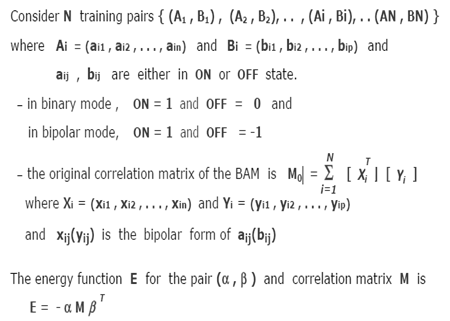Bidirectional Hetero-associative Memory
Introduction:-Kosko (1987) extended this network to two-layer bidirectional structure called Bidirectional Associative Memory (BAM) which can achieve hetero-association. The important performance attributes of the BAM is its ability to recall stored pairs particularly in the presence of noise.
Definition : If the associated pattern pairs (X, Y) are different and if the model recalls a pattern Y given a pattern X or vice-versa, then it is termed as hetero-associative memory.
Bidirectional Associative Memory (BAM) Operations
BAM is a two-layer nonlinear neural network. Denote one layer as field A with elements Aiand the other layer as field B with elements Bi.
The basic coding procedure of the discrete BAM is as follows.

Energy Function for BAM:-A system that changes with time is a dynamic system. There are two typesof dynamics in a neural network. During training phase it iteratively updateweights and during production phase it asymptotically converges to the solutionpatterns. State is a collection of qualitative and qualitative items that characterizethe system e.g., weights, data flows. The Energy function (or Lyapunov function) is a bounded function of the system state that decreases with time and thesystem solution is the minimum energy.
Let a pair (A, B) defines the state of a BAM.
− To store a pattern, the value of the energy function for that pattern has to occupy a minimum point in the energy landscape.
− Also adding new patterns must not destroy the previously stored patterns.
The stability of a BAM can be proved by identifying the energy function E with each state (A , B) .
− For auto-associative memory: the energy function is
E (A) = - AM AT
− For bidirectional hetero associative memory: the energy function is
E(A, B) = - AM BT ; for a particular case A = B , it corresponds
to Hopfield auto-associative function.